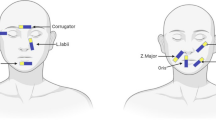Abstract
Introduction
Facial palsy is a condition where the patients lack voluntary movement on the affected side of the face and are not able to convey their emotions. Besides that, they also succumb themselves to social isolation. Various techniques have been devised to overcome this devastating problem. The aim of this article is to evaluate and compare facial muscle function before and after facial reanimation with temporalis muscle galea pedicled flap by motion mode echomyography in patients with long-standing facial paralysis.
Patients and Methods
Ten patients with long-standing facial paralysis were included in the study (six patients with LMN palsy and four patients with facial weakness involving specific peripheral branches), and they subsequently underwent facial reanimation surgery with temporalis galea pedicled flap. These patients were followed postoperatively for a period of 1–2 years and were subjectively graded as excellent, good, fair and poor and objectively evaluated by M-mode echomyography, and the results were evaluated and statistically analyzed.
Results
Subjectively, out of 6 patients with LMN palsy, results were graded as excellent in 2 cases, good in 3 cases, fair in 1 case, and out of 4 patients with weakness in specific facial nerve branches, the subjective results were excellent in 2 cases, good in 1 case and fair in 1 case. Objectively, the effect of transposed temporalis galea on orbicularis occuli, levator labii superioris and orbicularis oris was found to be statistically significant in patients with LMN palsy.
Conclusion
Our study proves the versatility of temporalis muscle galea pedicled flap in cases of long-standing facial paralysis by motion mode echomyography.



Similar content being viewed by others
References
Hu ZQ, Ogawa R, Aoki R, Gao JH, Hyakusoku H (2005) Temporalis muscle-galea pedicled flap for reconstruction of long standing facial paralysis. J Nippon Med Sch 72(2):105–112
Breidahl AF, Morrison WA, Donato RR, Riccio M, Theile DR (1996) A modified surgical technique for temporalis transfer. Br J Plast Surg 49:46–51
Harii K (1979) Microneurovascular free muscle transplantation for reanimation of facial paralysis. Clin Plast Surg 6(3):361–375
Harii K, Asato H, Yoshimura K, Sugawara Y, Nakatsuka T, Ueda K (1998) One stage transfer of the latissimus dorsi muscle for reanimation of a paralyzed face: a new alternative. Plast Reconstr Surg 102(4):941–951
Maegawa J, Saijo M, Murasawa S (1999) Muscle bow traction method for dynamic facial reanimation. Ann Plast Surg 43(4):354–358
Boahene KD (2008) Dynamic muscle transfer in facial reanimation. Fac Plast Surg 24(2):204–210
May M, Drucker C (1993) Temporalis muscle for facial reanimation. A 13 year experience with 224 procedures. Arch Otolaryngol Head Neck Surg 119(4):378–382
Abbasi R (2013) Facial reanimation by masseteric muscle—mandibular periosteum transfer. World J Plast Surg 2(1):44–46
Revenaugh PC, Knott PD, Scharpf J, Fritz MA (2012) Simultaneous anterolateral thigh flap and temporalis tendon transfer to optimize facial form and functional after radical parotidectomy. Arch Fac Plast Surg 14(2):104–109
Sidle DM, Fishman AJ (2011) Modification of the orthodromic temporalis tendon transfer technique for reanimation of the paralyzed face. Otolaryngol Head Neck Surg 145(1):18–23
Clark JM, Shockley WW (2002) Management and reanimation of the paralyzed face. In: Papel ID (ed) Facial plastic and reconstructive surgery. Thieme, New York, pp 660–685
Labbe D (1997) Lengthening of temporalis myoplasty and reanimation of lips. Technical notes. Ann Chir Plast Esthet 42(1):44–47
Cuccia G, Shelly O, d’Alcontres FS, Soutar DS, Camilleri IG (2005) A comparison of temporalis transfer and free latissimus dorsi transfer in lower facial reanimation following unilateral longstanding facial palsy. Ann Plast Surg 54(1):66–70
Frey M, Giovanoli P, Tzou CH, Kropf N, Friedl S (2004) Dynamic reconstruction of eye closure by muscle transposition or functional muscle transplantation in facial palsy. Plast Reconstr Surg 114(4):865–875
Mathog RH, Ragab MA (1985) Temporalis muscle-galea flap in facial reanimation. Arch Otolaryngol 111(3):168–173
Rajaram PC, Naidu ME, Rao SP (2002) M-Mode echomyography: a new technique for the functional assessment of striated muscles. Indian J Radio Imaging 12:537–541
Baker DC, Conley J (1979) Regional muscle transposition for rehabilitation of the paralyzed face. Clin Plast Surg 6(3):317–331
Balaji SM (2002) A modified temporalis transfer in facial reanimation. Int J Oral Maxillofac Surg 31(6):584–591
Casler JD, Conley J (1990) Simultaneous dual system rehabilitation in the treatment of facial paralysis. Arch Otolaryngol Head Neck Surg 116(12):1399–1403
May M (1984) Muscle transposition for facial reanimation. Indications and results. Arch Otolaryngol 110(3):184–189
Habel G, Hensher R (1986) Versatility of temporalis muscle flap in reconstructive surgery. Br J Oral Maxillofac Surg 24(2):96–101
Gomez MM, Pereira H, da Silva AG, Rego JM, Almeida MA (1998) Facial paralysis. Neuro-muscular reconstruction techniques. Acta Med Port 11(3):209–218
Byrne PJ, Kim M, Boahene K, Millar J, Moe K (2007) Temporalis tendon transfer as part of a comprehensive approach to facial reanimation. Arch Fac Plast Surg 9(4):234–241
Croxson GR, Quinn MJ, Coulson SE (2000) Temporalis muscle transfer for facial paralysis: a further refinement. Fac Plast Surg 16:351–356
Cheney ML, McKenna MJ, Megerian CA, Ojemann RG (1995) Early temporalis muscle transposition for the management of facial paralysis. Laryngoscope 105:993–1000
Acknowledgements
The authors would like to acknowledge Dr.S. Rajaram—Professor and Head, Department of Radiology, for his help and guidance in doing the objective analysis for all these patients.
Funding
None.
Author information
Authors and Affiliations
Corresponding author
Ethics declarations
Conflict of interest
None.
Informed Consent
Informed consent and permission to use patient’s photographs have been obtained.
Additional information
Publisher's Note
Springer Nature remains neutral with regard to jurisdictional claims in published maps and institutional affiliations.
Rights and permissions
About this article
Cite this article
Chandrasekaran, B., Rekha, M., Neelakandan, R.S. et al. M-Mode Echomyography of Facial Muscle Function Following Facial Reanimation with Temporalis Muscle Galea Pedicled Flap: Analysis of Ten Cases with Review of Literature. J. Maxillofac. Oral Surg. 19, 571–578 (2020). https://doi.org/10.1007/s12663-019-01292-z
Received:
Accepted:
Published:
Issue Date:
DOI: https://doi.org/10.1007/s12663-019-01292-z




